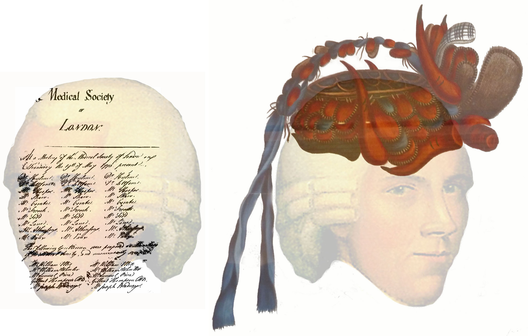John Coakley Lettsom1744–1815
Lettsom was a founder of the Medical Society of London. He is shown on the left in a notice of its first meeting, listing those present and those elected to membership. His portrait is not easy to see, but it can be discerned by squinting the eyes, shaking the head from side to side, viewing the page from a distance, removing your spectacles if you wear them – in fact any procedure that reduces the sharpness of the fine lines in the pattern which make up the motif. The pattern is derived from a notice listing those attending the first meeting of the Medical Society of London on May 19, 1773, as well as those proposed and accepted for membership. Artistic license has been taken with the notice for graphical reasons. The list of ten members has been presented in triplicate, which is appropriate since the membership was initially set at thirty physicians, surgeons and apothecaries; those of the proposed members are in duplicate so that the pattern would be a better carrier for the portrait. The portrait of Lettsom is derived from an oil painting and from an engraving which was copied from it. The portrait has been reduced to its minimal elements and then combined with the notice so that the principal features – eyes, nose and mouth – blend with the pattern of the text. The Medical Society of London was not the only one to be founded in late eighteenth century London. Lettsom did much to further the lot of the poor in receiving medical treatment in London. He also wrote about the history of medicine, and took a particular interest in its prescientific origins. The illustration on the right is derived from a hand coloured print in his History of the Origin of Medicine (1778), which was initially an oration delivered to the Medical Society of London. It shows a chaplet that was worn by the King of Senegal. The chaplet consisted of charms or Grigris, which warded off all manner of potential misfortunes and conferred power in battle. This is not unlike the wig worn by Lettsom. The chaplet cannot be considered successful in battle as the King was slain while wearing it.
